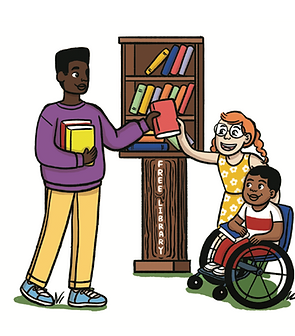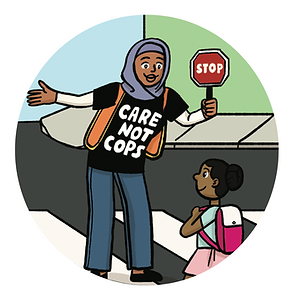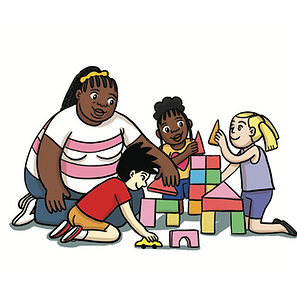

Ready to keep talking?
Explore additional resources, reading material and tips to help support your next conversation.
We Care: A First Conversation About Justice
All children are impacted by the violence in our society, whether they experience it directly or indirectly, and whether we talk to them about it or not. Researchers estimate that nearly half of all children experience physical violence at home. Gun violence is now the leading cause of death among children in the United States, and lockdown drills have become a routine part of most children’s lives. Patterns of violence in our society affect different groups of children in predictable and unjust ways. For example, Black and Latine children are significantly more likely to be murdered by police than their white peers. And approximately one in four girls experience sexual abuse. But it doesn’t have to be this way! All children deserve to grow up in a just society. As adults, it is our responsibility to work toward justice by building safer communities where kids can thrive. The work of abolition begins with us. We wrote this book to help young children acknowledge, repair, and transform the harm they experience throughout their lives. It’s okay to take a break, leave something out for now, or weave in stories of your own.
COMMUNITY
The word “community” can mean so many things, and it means different things to different people. So, what do we mean when we talk about community in the context of restorative and transformative justice? In this book, we present a definition of community that is all about connections. People are connected through relationships, and there are lots of different kinds: family and friends (people who we know and who know us), neighbors (people we recognize and who recognize us), and other community members (people we notice and who notice us). The Bay Area Transformative Justice Collective started using the word “pod” in 2014 to describe the networks of people we call on when we are in need of care and help. You can create a “pod map” together as a family by talking about the different relationships you and your family have in your community or pod, and who you go to when you feel sad, when you need help, or when you are hurt.

GIFTS & ABILITIES

Every person has a unique gift to offer their community. Some people are drawn to the role of caregiving. Some gravitate toward the roles of disruptor or guide. Every person’s body works differently, and can do different things. No two people are exactly the same—even identical twins are different from each other. Plus, nobody stays the same. Every person is changing, across their lifetime, and in different contexts. With your family at dinner time, talk about your unique gifts. What is something you can offer your home or school community? Are you a teacher? Do you experiment and innovate? Tell stories? If you’re working in a school, you might consider using Deepa Iyer’s Social Change Ecosystem Map as a reflection tool to support your community to better align our values with our practice.
MUTUAL AID & COMMUNITY CARE
In communities, we aren’t just connected to one another; we are interconnected. That means that what each person chooses to do impacts the whole community. While these ideas are radical in mainstream society, indigenous communities have long traditions rooted in collective responsibility and interdependence. Mutual aid is when people in a community join together to meet one another’s needs, especially when those needs aren’t being met by the systems in place, or by those in positions of power or authority. As you go through your day, try to notice who keeps you safe and cares for you, and include children in these conversations. Is there a neighbor who always tidies up your block? Is there a librarian who welcomes unaccompanied kids after school? Pay attention to and brainstorm opportunities to care for others, too, like filling up the community fridge. Include children in those actions if you can, and when you can’t, be sure to tell them about what you did and why.

SAFETY

As Micky ScottBey Jones teaches us, “there is no such thing as a ‘safe space,’ ” because “we exist in the real world.” And in the real world “we all carry scars and we have all caused wounds.” That’s because we are human, and humans make mistakes. Most of the time, we set out with good intentions.We want to connect, or play, or express care.We want to help make the world a better place. And yet, we still hurt one another. Sometimes people hurt one another on purpose. And that’s very scary. We also know that our society’s dominant strategies of punishment (including criminalization, policing, prosecution, and incarceration) do not keep us safe. To the contrary, these strategies perpetuate systemic racism and compound harm. Effective solutions start from within the communities that are being targeted. Developing these solutions requires us to invest in marginalized communities. Homes and classrooms are ideal sites to begin practicing nonpunitive, transformative approaches to preventing violence and cultivating community. One way to start is by talking about emotions regularly. This is a way to start cultivating relationships and a feeling of safety at home or in the classroom. Young children are more likely to talk and share feelings when they feel safe to do so.
COLLECTIVE RESPONSIBILITY
The dominant culture in the United States is highly individualistic. That means that when something bad happens, we often look for one person to blame. Oftentimes, we’re encouraged to blame the victim themself. Most of us are very practiced in ignoring complexity and identifying a single figure upon whom to heap all our collective responsibility. And it can feel cathartic! When we slow down to really unpack the specific manifestations of systemic racism in our homes and communities, it’s almost always clear that regardless of how the problem began, each and every member of the community is impacted by it, in different ways, for different reasons, and has a role to play in enacting the solution. In your home or classroom, who takes responsibility for what? Some questions that might be helpful to reflect on are: How were you affected by what happened? How were others affected? What role did you play in it? What role could you play in making things right?

NO BAD GUYS

The dominant culture in the United States is rooted in Western Christianity and white supremacy. In this worldview, issues are framed with binaries: good/bad, right/wrong, us/them. Even ideas like heaven/hell, male/female, and mind/body are examples of this kind of either/or approach to understanding the world. This way of thinking can limit our ability to engage with the true complexity of most of our society’s pressing challenges. It has certainly shaped the way we talk about justice: perpetrator/victim, innocent/guilty, good guys . . . and bad guys. Children pick up on these ideas and often explore them in dramatic play. Participating in this kind of play with young children can give you a better sense of what they understand, provide authentic opportunities to clarify misinformation, and to practice strategies to work through complex social problems. When young children ask, “Are they a good guy or a bad guy?” it’s okay for your answer to be complex—because often that is the reality. You can say something like: “I don’t believe in good guys and bad guys. I think that everyone always has goodness inside of them and that most people want to do the right thing. I know that everyone makes mistakes, and that sometimes people do bad things on purpose. I believe that every day we have another chance to make a new choice. What do you think? What do you believe?”
JUSTICE
Like community, “justice” is a word that means different things to different people. Restorative justice is how we work on a problem as a community to make things right again for everyone. Transformative justice includes thinking of ways to prevent it from happening again by addressing the root cause. In the book, we explore these ideas using an example of the police sweeping an encampment of unhoused people. This common response criminalizes poverty and attempts to address a community problem with punishment. As an alternative, we show the many ways that the community could choose to care for their unhoused neighbors in the short, medium, and long term: by sharing homemade food, using a community fridge, and organizing for permanent affordable housing. In the block scene, we show another example of restorative and transformative justice. The children talk about their feelings and decide to build the tower in a new way. The grown-up apologizes, which builds the trust needed to find transformative solutions. Repair is how we move forward, and it is ongoing work. One of the most powerful ways for children to experience repair is for their grown-ups to apologize to them. When you apologize to children, you not only build that trust, but you also teach them that people with power must be held accountable.

